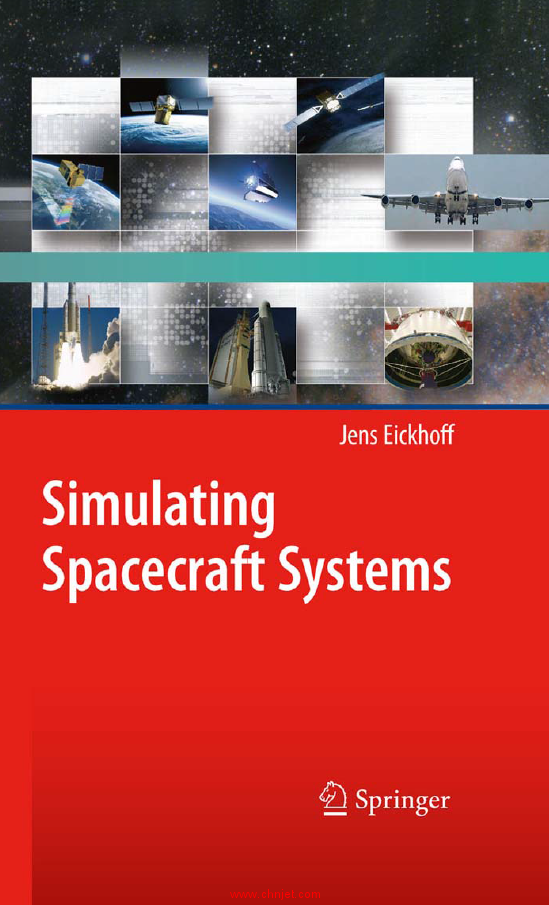马上注册,结交更多好友,享用更多功能,让你轻松玩转社区。
您需要 登录 才可以下载或查看,没有账号?立即注册

×
《Simulating Spacecraft Systems》
模拟航天器系统
作者:Jens Eickhoff
出版社:Springer
出版时间:2009年
《Simulating Spacecraft Systems》

《Simulating Spacecraft Systems》

《Simulating Spacecraft Systems》

《Simulating Spacecraft Systems》

目录
List of Abbreviations.................................................................................................XV
Notation of Variables and Symbols..........................................................................XIX
Introduction............................................................................................................. XXI
Part I Simulation Based System Development
1 Complex Systems in Spaceflight..............................................................................3
2 System Simulation in System Engineering.............................................................11
2.1 Development Process Phases for Spacecraft................................................12
2.2 A System, its Control Functions and their Modeling........................................14
2.3 Algorithms, Software and Hardware Development and Verification................16
2.4 Functional System Validation..........................................................................19
3 Simulation Tools for System Analysis and Verification...........................................23
3.1 Tools for System Design and Dimensioning...................................................26
3.1.1 Tools for System Predesign and Conception...........................................26
3.1.2 Functional System Analysis Tools for Phase B........................................29
3.2 System Verification Tools................................................................................33
3.2.1 Functional Verification Bench (FVB)........................................................35
3.2.2 Software Verification Facility (SVF).........................................................36
3.2.3 Hybrid System Testbed (STB).................................................................42
3.2.4 Electrical Functional Model (EFM)...........................................................47
3.2.5 Spacecraft Simulator for Operations Support..........................................51
3.3 Infrastructure History......................................................................................52
4 Testbench Components in Detail...........................................................................55
4.1 Control Consoles............................................................................................56
4.2 Test Procedure Editors and Interpreters.........................................................61
4.3 Special Checkout Equipment..........................................................................66
4.4 Simulator-Frontend Equipment.......................................................................69
4.5 Spacecraft Simulators.....................................................................................72
4.6 Equipment and System Models......................................................................74
5 Spacecraft Functionality to be Modeled.................................................................79
5.1 Functional Simulation Concept.......................................................................80
5.2 Attitude, Orbit and Trajectory Modeling...........................................................83
5.3 Aspects of Structural Mechanics.....................................................................85
5.4 Thermal Aspects.............................................................................................86
5.5 Equipment Modeling.......................................................................................87
Part II Simulator Technology
6 Numerical Foundations of System Simulation.....................................................107
6.1 Introduction to Numerics...............................................................................108
6.2 Modeling of System Components as Transfer Functions..............................109
6.3 Components with Time Response................................................................110
.
6.4 Balance Equations........................................................................................112
6.4.1 Equation Set for Fluid Systems..............................................................112
6.4.2 Equation Set for Spacecraft Dynamics..................................................116
6.4.3 Equation Set for Spacecraft Electrics....................................................117
6.5 Classification of Partial Differential Equations...............................................118
6.6 Transformation of PDEs into Systems of ODEs............................................119
6.7 Numerical Integration Methods.....................................................................121
6.8 Integration Methods Applied on System Level..............................................126
6.9 Boundary Value Problems in System Modeling............................................135
6.10 Root Finding Methods for Boundary Value Problems.................................140
6.11 Numerical Functionalities for Control Engineering......................................143
6.11.1 Mathematical Building Blocks and their Transformation to RPN..........143
6.11.2 Linearization of System State Equations.............................................146
6.11.3 Linearization by Algorithmic Differentiation..........................................148
6.12 Semi-Implicit Methods for Stiff DEQ Systems.............................................149
7 Aspects of Real-time Simulation..........................................................................155
7.1 Time Definitions............................................................................................156
7.2 Time Synchronization...................................................................................157
7.3 Modeling Time in a Simulator........................................................................159
7.4 Real-time Parallel Processing.......................................................................163
8 Object Oriented Architecture of Simulators and System Models..........................167
8.1 Objectives of Simulator Software Design......................................................168
8.2 The Model Driven Architecture......................................................................170
8.3 Implementation Technologies - Programming Languages............................173
8.4 Implementation Technologies - The Unified Modeling Language (UML).......174
8.4.1 Code Generation from UML...................................................................182
8.4.2 Designing a Simulator Kernel using UML..............................................185
8.4.3 Designing Spacecraft Equipment Models with UML..............................187
8.5 Implementation Technologies - The Extensible Markup Language (XML)....190
8.6 Implementation Technologies - Modeling Frameworks.................................198
8.7 From a Model Specification to the Simulation Run.......................................200
8.7.1 From Equipment Documentation to the Model Specification.................200
8.7.2 Application Example - Fiber-optic Gyroscope........................................202
8.7.3 Writing an Equipment Model Specification............................................203
8.7.4 Translation of the Model Specification into UML Based Design............206
8.7.5 Code Generation and Code Instrumentation.........................................208
8.7.6 Integrating the Model into the Simulator................................................213
8.7.7 Configuration Files for a Simulation Run...............................................216
8.7.8 Simulation Run......................................................................................221
9 Simulator Development Compliant to Software Standards..................................223
9.1 Software Engineering Standards – Overview...............................................224
9.2 Software Classification According to Criticality.............................................227
9.3 Software Standard Application Example.......................................................228
9.4 Critical Path in Spacecraft Development......................................................240
9.5 Testbench Configuration Control vs. OBSW and TM / TC............................243
9.6 Testbench Development Responsibilities.....................................................245
9.7 Lessons Learned from Projects....................................................................246
10 Simulation Tools in a System Engineering Infrastructure...................................249
10.1 The System Modeling Language (SysML)..................................................251
XII Contents
XIII
10.2 System Engineering Infrastructures............................................................257
10.3 Standards for Data Exchange Between Engineering Tools........................263
Part III Advanced Technologies
11 Service Oriented Simulator Kernel Architectures...............................................271
11.1 SOA Implementation of Simulator Initialization...........................................274
11.2 SOA Implementation of the Kernel Numerics..............................................277
11.3 Orchestration of the Computation and Function Distribution.......................280
12 Consistent Modeling Technology for all Development Phases...........................281
12.1 Requirements to a Cross-Phase Design Infrastructure...............................284
12.2 Cross-Phase Simulation Infrastructure and Engineering Steps..................288
13 Knowledge-Based Simulation Applications........................................................295
13.1 Modeling of Information for Rule-Based Processing...................................297
13.2 Accumulation of Knowledge on a System's Behavior.................................300
13.3 Coupling of Knowledge-Processor and simulated / real System................301
13.4 Application of Expert Systems for User Training.........................................314
13.5 Implementation Technology: Rules as Fact Filters......................................315
14 Simulation of Autonomous Systems...................................................................319
14.1 Testing Conventional on-board Software Functions....................................320
14.2 Testing Failure Management Functions......................................................321
14.3 Testing Higher Levels of System Autonomy................................................322
14.4 Implementations of Autonomy and their Focus...........................................324
14.4.1 Improvement Technology – on-board SW / HW Components.............326
14.4.2 Improvement Technology – Optimizing the Mission Product...............328
14.4.3 Enabling Technology – Autonomous OBSW for Deep Space Probes. 330
15 References.........................................................................................................333
Index........................................................................................................................349
专业书籍
下载地址:(回复后可见)
| ![]()